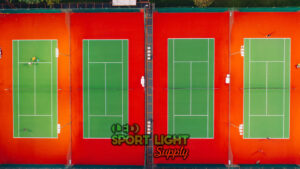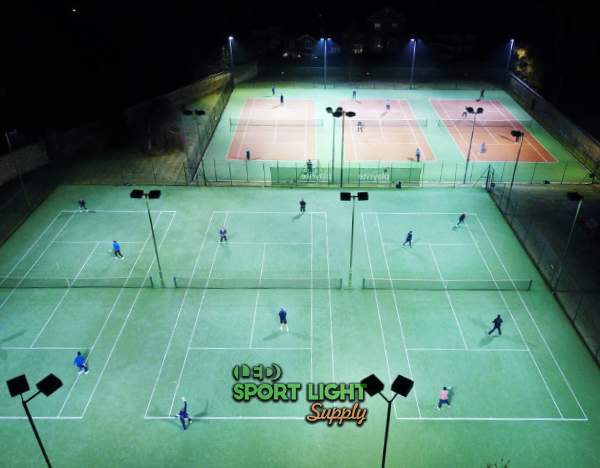
Table of Contents
ToggleTennis is a sport that requires precision, not only from players but also from the environment in which it is played. The dimensions of a tennis court are carefully regulated to ensure fairness and consistency across games. Whether for recreational or professional play, understanding the dimensions of a tennis court is fundamental for setting up the proper infrastructure, including the lighting system. This article delves into the dimensions of a tennis court, the lighting requirements, and the placement of LED lights to ensure optimal conditions for playing at any level.

A standard tennis court measures 78 feet in length, making it long enough to accommodate fast-paced rallies that require players to cover significant ground. For doubles matches, the width of the court is 36 feet, which includes the alleys on either side of the center line, allowing for more space to maneuver and strategize. In singles play, however, the court width is reduced to 27 feet, as the alleys are not used, focusing the playing area on the central portion of the court. Despite this reduction in width, the length of the court remains the same for both singles and doubles play.
The net plays a crucial role in tennis, dividing the court into two halves. It stands at 3.5 feet high at the posts and tapers down to 3 feet at the center. This height regulation is consistent for both singles and doubles matches, ensuring that the net does not obstruct play. The net’s placement and tension are also important, as they impact the ball’s trajectory and can affect the pace of a match. The height specifications are designed to offer a fair challenge for players of all skill levels.
Proper lighting is fundamental to ensure visibility and safety during both day and night matches. The International Tennis Federation (ITF) has established minimum lighting standards for tennis courts to ensure that players can perform at their best, regardless of the time of day. These lighting requirements vary depending on the level of play, with different levels of illuminance needed for recreational and professional matches.
For recreational tennis matches, the ITF recommends a minimum average illuminance of 300 lux. This level of lighting is sufficient for casual games, ensuring that players can see the ball clearly and judge its speed and direction effectively. Recreational courts are typically found in public parks, clubs, and residential areas where play takes place at various times, often in the evening or during overcast weather conditions. Achieving the required level of illuminance can help prevent accidents and ensure that players enjoy a comfortable experience.
When it comes to professional matches, the lighting requirements become more demanding. The ITF specifies that a minimum of 1,000 lux is needed to provide high-quality lighting for competitive play. This higher level of illumination is necessary to ensure that players, umpires, and spectators have optimal visibility of the match, especially in televised events where every detail needs to be visible. Professional-level lighting systems take into account the demands of television broadcast standards, where clarity and detail are of utmost importance.
Regardless of the illuminance level, one of the most important aspects of lighting design for a tennis court is uniformity. The lighting system should be designed to minimize shadows and ensure an even distribution of light across the entire playing surface. A uniform lighting system ensures that no part of the court is significantly darker than others, which can affect player performance and the overall quality of the match.
 LED lighting has become the preferred choice for illuminating tennis courts due to its efficiency and superior performance compared to traditional lighting options. LED lights offer several advantages, including energy savings, durability, and consistent lighting output. They also provide more control over the lighting distribution, allowing for precise adjustments to avoid glare and optimize visibility.
LED lighting has become the preferred choice for illuminating tennis courts due to its efficiency and superior performance compared to traditional lighting options. LED lights offer several advantages, including energy savings, durability, and consistent lighting output. They also provide more control over the lighting distribution, allowing for precise adjustments to avoid glare and optimize visibility.
LED lights are highly efficient, consuming less energy than traditional lighting systems such as halogen or metal-halide lamps. This makes them a cost-effective solution for both public and private tennis courts. Additionally, LEDs have a longer lifespan, which reduces maintenance costs and the frequency of bulb replacements. In terms of lighting performance, LED lights produce less heat, which helps to create a more comfortable environment for players. Furthermore, the quality of light produced by LEDs is superior, offering clearer visibility with less distortion of colors.
The placement of LED lights is another crucial consideration when designing the lighting system for a tennis court. Typically, LED floodlights are mounted on poles positioned around the perimeter of the court. These poles are usually between 25 to 40 feet high, depending on the specific needs of the court and the surrounding environment. The height and angle of the poles are adjusted to minimize glare and ensure even coverage across the court. A well-designed lighting system will have the lights strategically placed to cover all areas of the court, ensuring that no part is left in the dark.
The number of LED floodlights required for a tennis court depends on several factors, such as the court’s size, the type of lighting required, and the specific location. A typical setup might involve four to eight LED floodlights, which are sufficient to provide the required level of illuminance and uniformity for most courts. The exact number and placement will vary based on the layout of the court and other environmental factors like surrounding structures, trees, or nearby buildings that could obstruct light distribution.
Achieving proper lighting distribution is a key part of ensuring an optimal playing environment. One of the key metrics used to evaluate lighting performance is the uniformity ratio. This ratio measures how evenly the light is spread across the entire surface of the court. The ideal uniformity ratio for a tennis court is at least 0.5, meaning that the light level in any given spot should not fall below half of the average illuminance across the court. A well-designed lighting system ensures that there are no overly bright or dark spots on the court, which can disrupt the flow of the game and make it harder for players to anticipate the ball’s movement.
While the dimensions of a standard tennis court are clearly defined, there are instances where courts may deviate from the norm. For example, some private or non-regulation courts may vary in size, requiring a custom lighting design. In these cases, the principles of uniform lighting and adequate illuminance still apply, but adjustments may be necessary to account for the specific layout and dimensions of the court. Whether the court is larger or smaller, the lighting system must be tailored to ensure that the playing surface is fully illuminated and that shadows are minimized.
In designing a tennis court for optimal performance, attention to detail in both court dimensions and lighting is essential. The standards for court size and lighting set by the ITF provide a solid foundation for ensuring that players enjoy a fair and enjoyable experience. By choosing high-quality LED lighting and carefully planning its placement and distribution, courts can be illuminated in a way that maximizes visibility and minimizes distractions. Whether for recreational play or professional competition, a well-lit tennis court is key to supporting a high-quality game.
Drop us a line to receive a free lighting design